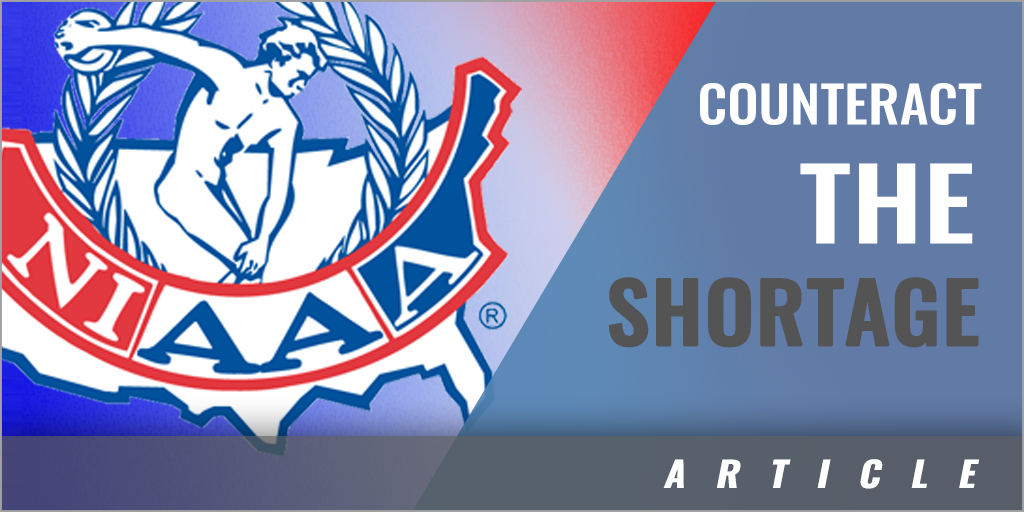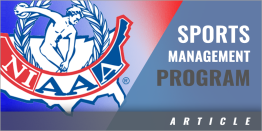|
By: Jon Winer, CMAA - Capital Region Education Council School District (CT) The shortage of officials is an issue of which we are all aware, and the trends are moving in the wrong direction. The Nebraska Schools Activities Association (NSAA) found that about 80% of sports officials quit within their first three years due to poor sportsmanship, according to a 2022 survey. While we have known about the issue for many years, for the most part, we have failed to act to change the course we are on. But there are things we can do now to curb the trends and prevent the worst possible outcomes. In our district, this is a priority. We have embarked on several efforts to counteract the decline of officials and to demonstrate our appreciation for them and their work. Coaching our coaches One of our major efforts is working with our coaches to make our expectations clear for how they interact with officials. Our coaches are required to greet the official in some way before the game. It is also strongly recommended they write down the first names of the officials on their game sheet or score book before the game begins. This ensures they are not yelling across the court or field, "Hey, ref" but rather, "Hey, Joe, can I ask you a question?" This subtle change humanizes the official and improves communication. We also teach our coaches that even when they don't agree with a call, they need to accept it and move on. When I was a young basketball coach, I was hired by Billy Taylor at Lehigh University. Billy's calm demeanor was new to me. I had always been coached by yellers and screamers, so that was all I knew, but Billy was different. When he disagreed with an official's call, he respectfully and calmly asked them to approach him. He would then cover his mouth and have a brief conversation in which he was able to get his point across to the official and do so in a way that the official was not "shown-up," nor did he further rile up players or spectators. Officials appreciated this, and Billy was named Patriot League Coach of the Year in 2003 and 2004. I often speak to coaches about their interactions with officials, and they express a feeling that they need to "stick up for their players." I work with our coaches to help them understand that yelling and screaming at officials is not the best way to accomplish getting their point across. Once coaches practice an approach like Coach Taylor's, they often come to understand and respect it, and they can begin to understand the power of focusing on the game and on what they can control. The E+R=O model (Event Plus Response Equals Outcome) has become popular across disciplines, and it certainly applies to coaching. While coaches (and others) have very little control over the events in their lives, they can control their responses to those events, and ultimately, it's our responses that determine the outcome. This method of thought can be applied to interactions with officials. We cannot control what we perceive to be bad calls, but we can control how we react to them, and our reactions will dictate whether we have a positive or a negative outcome. If we choose to yell and scream at the official, the call doesn't change, but we have now also caused other negative outcomes such as poor modeling for our players, a bad experience at our facility for the official, and/or a possible technical foul for ourselves. Focusing on the official's experience First, we strive to make the officials' experience at our facilities as positive as possible. We give each official a bottle of water and a snack upon entry. After each game, we email each official a link to a short survey about their experience. The survey, adapted from existing ones used by Southington High School and Abbott Technical High School, asks for feedback on key pieces of our approach and their personal experience. Here are the questions we include in the survey, and we ask them to use the following scale:
We also include a section requesting they provide any details for any "POOR" or "VERY POOR" ratings. Finally, we ask one open-ended question: Are there any other ways you think we can improve the experience for officials? Feel free to tell us the things we are doing well, too! Any further comments are greatly appreciated. The purpose of this survey is to inform us on whether we are upholding our values and what areas of growth we may have. The resulting data is shared with coaches and school administration. The survey also helps officials feel valued and know that we care about their experience. It gives them a voice, and that makes a big difference to officials. During its first year of use, the survey was completed more than 350 times. Officials as partners Through the feedback process, we have learned that officials have a lot to offer in terms of advice and ideas for our programs. For example, our facilities can be tricky in terms of the best way to house officials so that they feel safe, have enough room, and have access to showers. In the past, we have asked seasoned officials to come in and review our facilities to help us determine how to improve and better provide them with what they need. They are able to tell us which locations are preferable, and they often come up with creative, quick ways to improve their experience that a non-official may not identify as a solution, such as using a different entrance. Showing gratitude We believe our spectators often follow the lead of our coaches and student-athletes in regards to how they behave towards officials. Therefore, our league adopted sportsmanship bracelets for our officials. Before contests begin, team captains read the sportsmanship statement and present the officials with a sportsmanship bracelet. The goal of this action is for our appreciation of the officials to be seen, heard, and hopefully mirrored by the spectators throughout the game. While our officials appreciate the water and snacks that we provide them, we decided to go a step further this year. Our varsity football games are held on Saturday mornings at 11 am. In the week leading up to the game, we request that officials include their preferred type of donut with the game itinerary. Then, we make sure to have that donut ready for them upon their arrival. This small gesture was appreciated and made the officials feel special. Similarly, while we had traditionally presented officials with a t-shirt during Officials Appreciation Week, we only had extra-large shirts available, which was not ideal when an official would prefer a smaller or larger size. This year, once we knew the dates of the games, we made the extra effort to look up who the scheduled officials were and emailed them to request their preferred shirt size. We purchased an assortment of sizes and were then able to make sure each official received a t-shirt that fit them. While this was a little bit of extra work, personalization goes a long way to show appreciation and respect for our officials, and they certainly notice.
The shortage of officials is a concern for all of us, and it has hampered our ability to schedule games at the dates and times that we prefer. The bad news is that it continues to trend in a negative direction. The good news is that we have some control over where it is leading and can not only stop the negative trend but reverse it in a way so the pool of officials steadies and maybe even grows. And while there are things we can do to impact this issue, the question remains, will we act soon enough? |








